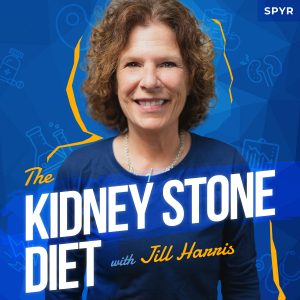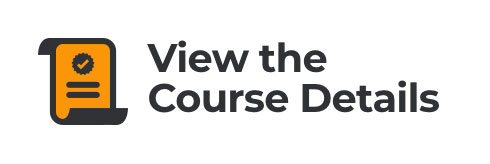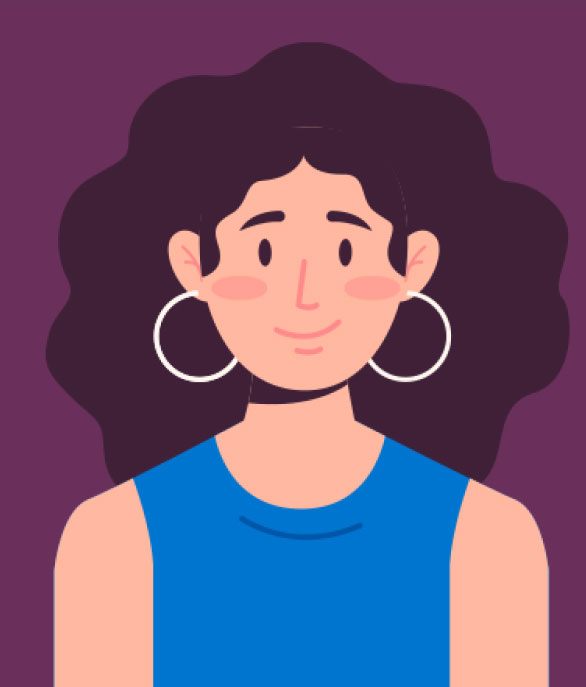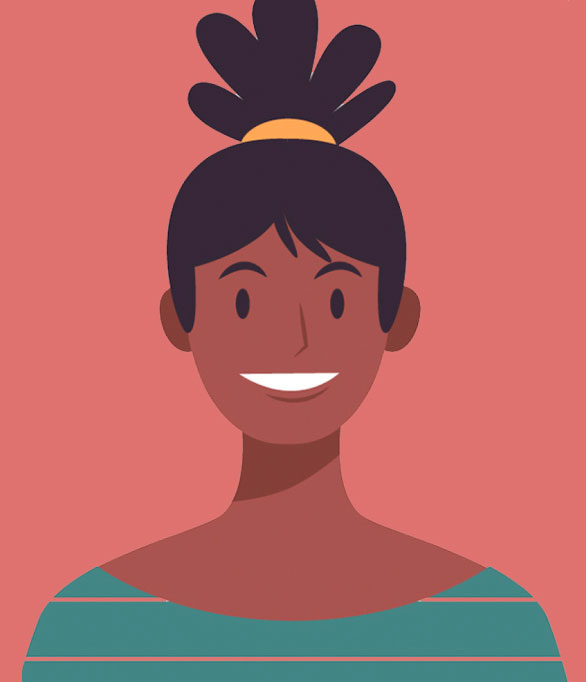This week Jill answers a listener question about oxalate, how to find updated oxalate information, and why so much of the oxalate data online is inconsistent.
Jeff Sarris: Welcome back to the Kidney Stone Diet podcast: a show about reducing your kidney stone risk and living your best life. I’m your host and fellow student, Jeff Sarris.
Jill Harris: And I’m Jill Harris, your kidney stone prevention nurse.
starts humming a melody
Jeff Sarris: I feel like we have like a game show, but we need a little theme music to go with that there. So before we dive into a question, we just have a nice message here that I wanted to share.
Listener Voicemail: “Hi! Just wanted to comment from Greensburg, Pennsylvania, that as usual, sales notes are making a move, a physical move relocation only proved to be helpful to you. Thanks, Jill, for all the uptakes and the upticks and for giving us advice to keep those kidneys well balanced and healthy. Thanks much from Greensburg, Pennsylvania. This is Suzanne.”
Jill Harris: Oh, Suzanne! Okay, so here’s the thing. I feel so lucky. We always get such people say such nice things, right? It’s so kind of them. The first thing I think of is “Wow, Suzanne, on her Sunday is calling in to say thank you.” So I don’t even know what to say when I get those, but I will graciously accept it, and Jeff accepts it. I want you guys to know that it is a privilege, it is a privilege to be able to come on here, Facebook, wherever the heck I am, wherever the heck Jeff is, and try to help people with this because we understand that there’s a lot of information out there. It’s conflicting, and it’s overwhelming. People don’t know what to believe. There’s not a lot of help, unless you really start seeking it out for yourself. So anything that we can add that will help you in this journey, it is a delight and it is a privilege and we are humbled by your response to us. So thank you so very much to take time out of your day and let us know how you feel that means the world to us.
It’s just such a satisfying career to be able to help. You know, look, you go into nursing and Jeff, I know I’ve told you this, but you know, at University of Chicago when I was there, years ago, working the floors, it’s like “oh, my God, it’s so stressful.” God bless those nurses, and doctors, everybody, because for patients to even be in-patient, you have to be really sick. So, you have all these patients. You’re trying to figure out, well, this one’s bleeding out, this one’s throwing up, who do I go to first? You just you don’t know, it’s just so bad. When I was going to nursing school, I thought, I’m just gonna sit by a bed, I’m gonna listen to people’s stories, I’m gonna rub their head, and hold their hand and I’m just gonna be there. There’s none of that.
So somehow, there’s none of that. Every day I would leave, and I’d be like, I just did the crappiest job ever because it wasn’t what I thought nursing was. Nursing is so incredibly hard and you’re always trying to figure out who to help first when everyone needs your help. So, to all the health professionals out there, in that kind of setting, man, do I have a lot of respect for you. I figured out a way, and Jeff has helped me to do this on our own terms, and to be able to take some time and really spend time with patients so you can listen and figure out how the best way is to help them. Maybe I’m not physically rubbing a brow, but to be able to touch your heart and to listen to someone who hasn’t been listened to properly before, well, we couldn’t ask for a better a better thing in the world. So thank you for sharing that with us. That makes us very happy when you do it’s very kind of you. Thank you, Suzanne.
Jeff Sarris: Yeah, that was great!
Jill Harris: Alright, come on. Let’s get to the show!
How Can I Find the Best Oxalate List?
Jeff Sarris: So, we do have more questions, of course. We are going to talk oxalate. I know we talk oxalate, but keep the questions coming because no question can be answered too many times. We want to be sure that we connect with you when you need to hear it in the way that you need to hear and that can really go a long way. So this is James.
Listener Voicemail: “Hey, Jill! I’m an American living in Japan. My name is James and I’m very grateful to have your podcast. I’m very grateful to see your website. It’s very useful to find these things. My question really is about some of the things that are on the oxalate list. I know that a lot of Japanese food does not have a lot of oxalates, but there are still some foods that I have some questions about. My question is really about where do I go to get really more up-to-date information on some of these new foods? And what do I do when I find that an item has, for example, different oxalate levels on different websites? It’s very confusing. Sometimes I look up things like oatmeal and find one website has one bit of information and then I go to another website and it has completely different information. Thanks.
Jill Harris: It’s a great question. And yes, that’s always the number one question with people. It’s always about oxalate. I’ll say this a million times, oxalate is such a small part of the Kidney Stone Prevention Diet. If I were living in Japan, I’d worry much more about the sodium. That’s what I’d be worrying about. However, his question is not about sodium, it’s about oxalate. They’re excellent questions, I can answer them all day long. People always have questions about them because the information is less than, so let’s talk about this. So first of all, where can you get updated information? There’s not a lot of updated information. It’s very costly, James, to study oxalate levels. Also, you’re going to see different values on different lists because the plant was grown – oxalate’s only in plants – the plant was grown in different soil conditions.
A plant grown in one part of the country, as opposed to another part of the country could have had different soil conditions, different light, different stuff. So, they’re gonna absorb minerals differently. It’s very complicated and so the growing conditions can affect oxalate levels. The researchers may all use different techniques. It’s not something we’ll see where it goes in the future. Oxalate is being blamed for a lot of different diseases. I don’t ever really comment on that. I just deal with my oxalate and the kidney stone world, but it’s getting very popular to talk about and peg oxalate with different disease processes. So, I think oxalate may be looked into more in the future. I never discount that new studies could be put out all the time. If you go to PubMed, you may be able to find some studies on newer foods, for sure.
I stick with the Harvard list because of the other advice I give with it. Once you take the other advice, you won’t have to worry so much about these other things you asked. And this is one of the reasons that I just believe in this as in the dietary world, but particularly for the Kidney Stone Diet and oxalate. You said different lists will have different oxalate values. I trust the oxalate list from Harvard; we trust those researchers. I’ve been helping patients understand that list for now 22 years. I look at the follow-up urine collections after educating patients on oxalate and they lower their urine oxalate, so I know that those values stand by, but it’s not just those values. It’s the other advice I give when somebody’s working with me. Eat normal amounts of food. Stop eating the same foods over and over – the highest oxalate foods – and not getting any calcium.
Most of this is a calcium problem. Because people aren’t getting their normal amounts of calcium, they have excess oxalate in their system. Of course, if you have malabsorption issues, you’re different. That advice does not hold true for you. You’re different than somebody who doesn’t have those issues. So, you may see even Harvard itself, it will have pancakes listed twice on their list. One says it’s higher than the others. What the hell? I don’t know. People say “Why?” I don’t know! I don’t know why that studied pancake is higher. I don’t know. Did they use a little bit more flour in that pancake? What did they do? I don’t know. But my point is always going to be this: you shouldn’t be freaking pancakes every day, anyway! It’s crap! It’s crap food!
So I’m always going to go back to this, whether it’s seven milligrams of oxalate or 14. In the grand scheme of things, that’s not the problem. It’s that you’re going to eat eight pancakes every day with no calcium, with lots of syrup – I know I’ll get some hate in the comments about it, but I’m gonna say it anyway, the whole reason to eat a pancake is to get syrup in your mouth. That’s a vehicle, just like spaghetti is a vehicle to get sauce. I mean, come on people. Who wants a piece of cake that doesn’t have icing? These are ways to sop the extra stuff up in our mouth. So pancakes, whether it’s 20 milligrams of oxalate or 10, doesn’t matter. It’s not the healthiest food and it’s not a big difference. The average person, the average kidney stone patient can easily have 100 milligrams of oxalate a day, unless your doctor has told you otherwise.
I know I’m saying different numbers all the time, but my point is it doesn’t matter. So plan your day. If you want to have more oxalate in one meal, then watch your oxalate for the rest of the day. Here’s the deal: people tend to deal with the minutiae. This is not a judgment, this is a fact. This is what I see day in and day out. People are so focused on pancakes, for example, that they think they have a whole other day to eat their food, so it’s only one part of their day. When you open up people’s view, on food, on how to incorporate a low oxalate diet, this list that list, it really doesn’t matter. Now, I say that because I’m looking at the big picture. Nobody here formed a stone in a week, a month, three months, unless you’re a very rare type of stone former. It takes a long time. It takes poor eating or overeating healthy foods in big portion sizes without any calcium, not getting enough fluids , and not watching sodium.
Especially, like I said, if you live in Japan, it’s going to be high sodium sauces. Although, I’m sure you’re probably paying attention to that. It’s all of these things. Long term, long term, long term! “Jill, Thanksgiving’s coming! Oh my god, there’s nothing to eat!” “It’s only one dinner.” “Okay, Jill.” But you know, as a cancer patient, my diet had to change, too, as I was going through my treatments. I understand you because even though I’ve done this my entire career, I was just like you. I’d be looking at this, “Oh my god, what am I gonna do? I got this, all this stuff. I can’t eat this. I can’t digest that.” But I wasn’t looking at the bigger picture, okay? So, I understand when you’re a patient, you get scared, it’s overwhelming, and you don’t want to screw it up because you don’t want to be sick again.
So believe me, with every cell in my being, I tell you I understand. I understand how we get sucked down in the minutiae. Like I said, it’s not a judgement. When I can teach somebody and educate somebody – looking at the bigger picture with your food and that one meal isn’t going to make a stone, or make you gain 50 pounds of weight – it’s what we do after the next choice. That’s what we do with the next choice. Don’t eat a high oxalate next choice. Don’t eat a really high caloric next choice. Get right back to it. I promise you guys, it makes me so happy to know that this is the answer. The answer is this. You can do whatever the heck you want. Just get right back on track with the next meal choice. You have nothing to worry about that. Now, what were we talking about?
Jeff Sarris: That is wonderful advice because one meal, one choice isn’t gonna derail everything. I fall in the same camp. Like when we first met, I really really wanted a list that had oxalate say one gram of x how much oxalate because I’m like a programmer. I’m analytical. I want to make that system to be like, oh, any recipe we can tell you the exact amount of oxalate in a serving like that. That’d be my dream. But it’s hard to, like get past that to be like, oh, that actually isn’t the exact number isn’t the point. It’s one of the larger puzzle.
Jill Harris: Yes, and I think that’s awesome, Jeff. And I think so many of my patients I talk to get, like, their pen and they get their graph paper, their diary. Tell me everything, I’m going to write it all down. And they want those numbers. Then there’s some people like me, where I’m a little bit of both. Then there’s some people that don’t want no number, you say the number two, and they’re going to faint. I mean, they just cannot. So you’ve got to know when you’re teaching anything in life, you’ve got to know who you came to teach. That’s what you got to think about, no matter what you have to say, it matters who you’re saying it to. I’m dealing with people from New York, Alabama, Maine, California, and I’ve got to know who I’m talking to on the phone, without any physical cues.
After doing that for decades, you quickly learn, what someone’s saying. What do they need? Who are they? Then, you can change how you’re going to give the information. So you can sit here and want to do numbers, but you’ve also got to understand the big picture. Everyone will learn things differently. Jeff likes numbers, but maybe you do not. So, you’ve got to understand how to do this in different ways. And I think that’s why we choose so many different venues to educate people: YouTube, Spotify, some people don’t want to see nobody and, most of all, me and my fuzzy hair. Jeff, yeah, he’s handsome, but no one wants to see me. You know, we do different styles because everyone’s different and they’re gonna soak it in in different ways. So it’s very important.
Listen, James, I want you to use the Harvard list, or find a list that that you think is working for you. I can only tell you that I see all these follow-up urines. When you see something that’s not on the Harvard list, have it once or twice a week, have it in a normal portion size. Not in 22 years, have I seen somebody make a stone with that advice, okay? Most of my patients stop making stones, not because I’m, you know, Glenda the Good Witch. It’s because they work their butt off and they incorporate the education I’m trying to teach them. Miracles happen when you learn how to eat properly in normal portions, and watch all the elements of the Kidney Stone Diet, all the goals, which you can find on kidneystonediet.com. On the start page, you can see all the goals of the Kidney Stone Diet.
Jeff Sarris: Just because you mentioned that the urine collection, we haven’t talked about that for a little bit, but that is a very important part of this entire process so you actually know where you’re at. And you have the urine analysis service on your site, where you help people break down actually what those results are and what it means to them.
Jill Harris: I love that service, and I always say I love that service. Because, then again, as a patient, I wish I was a little bit more educated going into my office visits. When you’re scared or anxious, or you’re in pain, or all the things you’re going through, you don’t know what you don’t know. It’s already intimidating going into the doctor’s office, even me as a nurse, I feel that way. So, you know, the urine analysis service, I can show you what your numbers mean, so you can talk to the doctor and you can get on a great treatment plan and have an educated conversation with your doctor and make the most out of those appointments and out of your copay.
I can’t tell you how many patients have said before they met that they went to their doctor and didn’t know what to ask, so they left just as bewildered before they went in. So get educated! It’s a 15 minute call. It’s very affordable, people! I base that upon my experience going to the doctor’s offices. So, it’s going to be a very short call, but man do I pack it in, so you can have a really educated office visit to get the most out of that office visit. So when you leave there, you feel in control. You feel like I got it going on. I know exactly what I’m gonna do. I’m never going to make another stone again. That’s what you need.
Jeff Sarris: Yeah, I think that’s a great spot to wrap. Thanks again, for listening. If you’re enjoying the show, we’d love it if you’d subscribe on YouTube. Give it a little thumbs up and leave a comment below the video. That really, really helps us reach more people and it means a lot to us. As always head on over to kidneystonediet.com to find links to everything, all the free content, all the premium content. You can get to the Kidney Stone Prevention group on Facebook, which is another another free piece of content with 10,000 plus people.
Jill Harris: Yeah, almost 11,000 people! It’s a very lively community and is supportive, kind, and nice. I’m the admin there, so I oversee it all. No one’s going off the rails in any way. That’s my baby that Facebook group. I love that group.
Jeff Sarris: Yeah, for sure! So that’ll do it for this week. Thanks again for listening and we’ll see you next time.
Jill Harris: Thanks very much, James. We appreciate your comments!














Leave a Reply